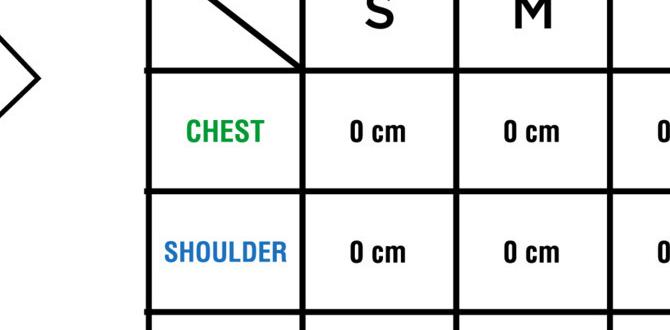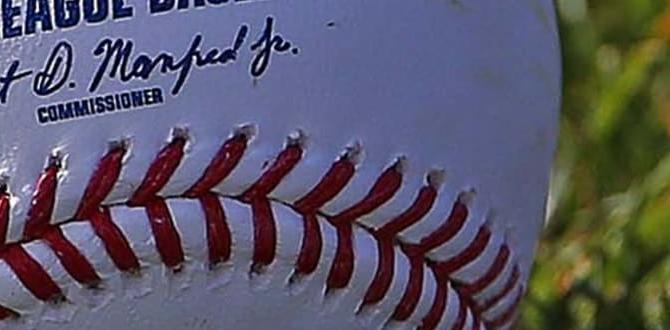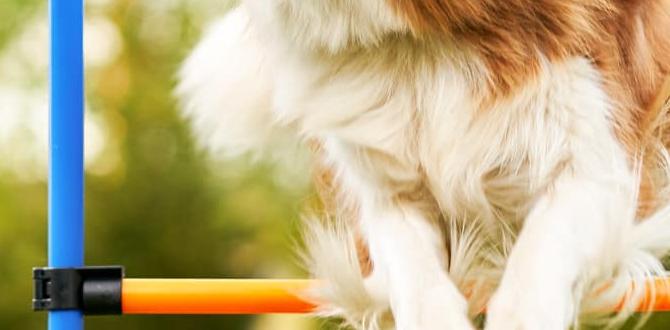Quick Summary
Choosing the right catcher’s glove for college is crucial for performance and protection. Essential features include size, padding, material, and a deep pocket. Selecting a glove that fits well and meets your needs will help you excel behind the plate and prevent injuries.
As a catcher, your glove is your most important piece of equipment. It’s what you use to frame pitches, block balls, and snag foul tips. When you step up to college ball, the game gets faster and the stakes get higher. That means you need a catcher’s glove that can keep up. But with so many options out there, finding the perfect one can feel overwhelming. Don’t worry! I’m here to break down exactly what you need to know to pick a catcher’s glove that will help you dominate behind the plate.
We’ll cover everything from the key features to look for, how to break it in, and what makes a glove truly “college-ready.” Get ready to find the mitt that’s going to be your best friend for the next few years!
Why Your College Catcher’s Glove Matters More Than Ever
Stepping onto a college baseball field means facing faster pitches, harder-hit balls, and more demanding game situations. Your catcher’s glove isn’t just an accessory; it’s a critical tool for your success and safety. A well-chosen glove provides the necessary protection against the sting of 90+ mph fastballs, helps you secure every pitch for a strong frame, and allows for quick transfers to throw out runners. A glove that’s too small, too stiff, or lacks adequate padding can lead to dropped balls, an increased risk of injury, and a loss of confidence. Investing time in selecting the right glove is investing in your performance.
Key Features of a College-Ready Catcher’s Glove
When you’re looking for a catcher’s glove for college, there are several key features that stand out. These aren’t just marketing terms; they’re design elements that directly impact how the glove performs and feels on your hand.
Size and Fit: The Foundation of Your Glove
Catcher’s gloves are typically measured from the top of the index finger to the heel of the glove. For college play, you’ll generally want a glove that’s between 32 and 34 inches. This larger size helps provide a bigger target for pitchers and a deeper pocket to secure the ball.
- For Big League Dreams: A 33-inch glove is a popular choice for many college catchers, offering a balance of coverage and control.
- Extra Coverage: If you’re facing exceptionally fast pitching or prefer a larger target, a 34-inch glove might be your best bet.
- Comfort is Key: Even with the right size, the glove needs to fit snugly. It shouldn’t be so tight that it restricts blood flow, but it shouldn’t be so loose that it slides around on your hand. Look for adjustable wrist straps or lacing systems that allow for a customized fit.
Deep Pocket: Securing Every Pitch
A deep pocket is essential for catchers. It’s the part of the glove where the ball lands. A deep pocket helps trap the ball, preventing it from popping out, and also allows for better grip and control. This is crucial for framing pitches and making sure the umpire sees every strike. The depth also offers an extra layer of cushioning for your hand.
Padding and Protection: Guarding Your Hand
College pitchers throw hard. Really hard. Your glove needs to have substantial padding, especially in the heel and palm, to absorb the impact of high-velocity pitches. Look for gloves with reinforced padding and high-quality materials designed to withstand the constant pounding. The more protection you have, the less pain you’ll feel and the more pitches you can confidently block or catch.
According to experts at the NCAA Baseball Rules, player safety is paramount. While rules focus on the game itself, the underlying principle of protecting athletes extends to their equipment choices.
Material: Leather Quality Makes a Difference
The material of your catcher’s glove significantly impacts its durability, feel, and performance. Most high-quality catcher’s gloves are made from genuine leather. There are different grades of leather, and higher-quality leather will mold better to your hand, become softer with use, and last longer.
- Full-Grain Leather: This is the highest quality leather, offering superior durability and an excellent feel. It requires a longer break-in period but will last for years.
- Top-Grain Leather: Also a good option, it’s a bit more processed than full-grain but still offers good durability and a quicker break-in time.
- Synthetic Leather: While more budget-friendly and often easier to break in, synthetic leather typically doesn’t offer the same level of durability, feel, or protection as real leather. For college, investing in genuine leather is usually recommended.
Glove Type: Custom vs. Off-the-Shelf
You have two main paths when selecting a catcher’s glove: buying a standard model or opting for a custom glove. Both have their pros and cons.
Off-the-Shelf Gloves
These are gloves you can purchase directly from a sporting goods store or online retailer. They come ready to go (though they still need breaking in) and are generally more affordable than custom options.
- Pros: Widely available, variety of brands and models, less expensive, can be tried on before purchasing (if bought in-store).
- Cons: May not be a perfect fit for your specific hand or playing style, limited customization options.
Custom Gloves
Many glove manufacturers offer custom design options where you can choose the size, color, webbing, and even add personal embroidery. This allows you to create a glove that’s perfectly tailored to your preferences.
- Pros: Perfect fit and feel, unique look, personalized design, can often specify features like padding density and pocket depth.
- Cons: Significantly more expensive, longer wait time for production and delivery, cannot be tried on before purchase, limited return options.
Top Glove Brands for College Catchers
Several brands have built a strong reputation for producing high-quality catcher’s gloves that stand up to the demands of college baseball. While personal preference plays a big role, these brands consistently deliver performance and durability.
Factors to Consider When Choosing a Glove Brand:
- Reputation: Look for brands trusted by professional and college players.
- Material Quality: Ensure they use high-grade leather.
- Construction: Check for sturdy stitching and reinforced areas.
- Player Reviews: See what other catchers are saying about specific models.
Popular Brands and Their Strengths:
| Brand | Typical Glove Sizes | Key Features Often Praised | Best For |
|---|---|---|---|
| Wilson | 32″-34″ | A2000/A2K series known for exceptional feel, deep pockets, and durability. Often preferred for their comfort and ease of break-in. | Overall performance, comfort, and ability to mold to hand. |
| Rawlings | 32″-34″ | Heart of the Hide and Pro Preferred series offer premium leather, robust padding, and classic catcher’s mitt designs. Known for their longevity. | Durability, traditional feel, and excellent protection. |
| Mizuno | 33″-34″ | Global Elite series features innovative designs, high-quality leather, and often a lighter feel. Good for catchers prioritizing agility. | Lightweight feel, modern design, and quick break-in. |
| All-Star | 32″-33″ | Renowned for their exceptional protective qualities, especially in their MVP catcher’s mitts. Many professionals use their gear. | Maximum protection and reliable performance. |
| SSK | 32″-33.5″ | Gaining popularity for their quality leather, ergonomic designs, and thoughtful construction. Offer a great feel and responsiveness. | Comfort, unique designs, and premium feel. |
When exploring these brands, visit their official websites or reputable baseball equipment retailers. Many offer detailed product descriptions and specification charts that can help you compare models. For example, Rawlings often highlights the specific glove patterns they use, like the “Catcher’s Mitt” pattern, which is designed for that specific role.
How to Break In Your College Catcher’s Glove
A catcher’s glove is stiff when it’s new. Breaking it in properly is essential for making it conform to your hand and creating that crucial deep pocket. This process takes time and patience, but it’s worth it. Remember, your glove is an extension of your hand!
Step-by-Step Glove Breaking:
- Gather Your Supplies: You’ll need glove oil or conditioner (like neatsfoot oil or specialized glove butter), a rubber mallet or a glove-shaping tool, baseballs, and a way to form the glove (like rubber bands or a glove trap).
- Apply Glove Conditioner: Start by applying a small amount of conditioner to the leather. Don’t overdo it; too much oil can actually damage the glove. Work it into the palm and fingers, focusing on the areas that need to be softened.
- Work the Pocket: The key to breaking in a catcher’s mitt is developing a deep, usable pocket. Take a baseball and place it in the pocket. Then, close the glove around the ball and hold it firmly. You can use rubber bands or a glove strap to keep the glove closed with the ball inside. Repeat this several times.
- Mallet Work: Gently use a rubber mallet or the heel of your hand to pound the glove, especially the heel and the edges of the pocket. This helps soften the leather and create the desired shape. Be careful not to hit it too hard, as you can damage the stitching or leather.
- Flex and Fold: Continuously open and close the glove by hand. This manual manipulation is one of the best ways to get the glove to feel natural and responsive.
- Play Catch: The best way to break in a glove is to use it. Spend time playing catch with a teammate or even throwing the ball against a wall and catching it yourself. This will help the glove mold to your hand and pocket even further.
- Storage: When you’re not using the glove, store it with a ball in the pocket, secured with a strap or rubber band. This helps maintain the pocket’s shape. Never store it flat.
Important Breaking-In Tips:
- Avoid the Oven or Microwave: Many people suggest heat to speed up the process, but this can dry out and crack the leather, severely damaging your expensive glove.
- Be Patient: A proper break-in can take weeks. Don’t rush it.
- Consistency is Key: Spend 15-30 minutes each day working on your glove.
Maintaining Your Catcher’s Glove for Longevity
Your catcher’s glove is an investment. Proper maintenance will ensure it performs at its best for your entire college career and beyond. It’s like taking care of your cleats or your helmet; consistent care makes a big difference.
Regular Maintenance Schedule:
- After Every Use: Wipe down the glove with a dry or slightly damp cloth to remove dirt and sweat.
- Weekly/Bi-Weekly: Apply a thin layer of quality glove conditioner. Work it into the leather panels, especially the pocket and webbing. Let it sit for a few hours or overnight, then wipe off any excess.
- Deep Cleaning (Monthly or As Needed): If the glove is particularly dirty, you might need a more thorough cleaning. Use a specialized leather cleaner, following the product instructions carefully. Always test in an inconspicuous area first.
- Restringing (As Needed): Over time, laces can fray or break. If you notice this, replace them promptly to maintain the glove’s structure. Many sporting goods stores offer restringing services.
For further insights into equipment care, resources like the Baseball America website often feature articles from experienced players and coaches on maintaining gear.
Common Problems and Solutions with Catcher’s Gloves
Even with the best glove and care, you might encounter a few common issues. Knowing how to address them can save your glove and your game.
Problem: Glove is Too Stiff
- Solution: Continue with the break-in process using glove oil and gentle mallet work. Playing catch regularly is the most effective solution. Ensure you used a quality leather glove to begin with.
Problem: Glove is Too Loose or Floppy
- Solution: This often happens after a lot of use or an improper break-in. Try tightening the wrist strap. If that doesn’t work, you might need to have the laces re-tightened by a professional. A glove that’s too loose won’t provide the necessary support or pocket.
Problem: Ball is Popping Out of the Pocket
- Solution: This could be a sign the pocket isn’t deep enough, or the glove is too open. Focus on glove drills that emphasize closing the glove around the ball. You may need to adjust your catching technique to ensure you’re using the pocket effectively.
Problem: Hand Soreness or Pain
- Solution: Ensure you have adequate padding in your glove. If pain persists, consider a glove with more padding or a receiver’s pad worn inside the glove. Proper technique for blocking and receiving also plays a huge role in hand safety.
Frequently Asked Questions (FAQs)
Q1: What size catcher’s glove do I need for college?
For college play, catcher’s gloves typically range from 32 to 34 inches. A 33-inch glove is very common and offers a good balance of a large target and control. It’s always best to try gloves on if possible to see what feels most comfortable and provides the best coverage for your hand.
Q2: How long does it take to break in a new catcher’s glove?
Breaking in a new catcher’s glove can take anywhere from a few weeks to a couple of months, depending on the leather quality and how consistently you work on it. It involves conditioning, flexing, and regular use playing catch. Patience is key!
Q3: Is a custom catcher’s glove worth the extra cost for college?
A custom glove offers a personalized fit and feel that can be highly beneficial, especially at the college level where performance is critical. While more expensive, if you have specific needs or preferences that off-the-shelf gloves don’t meet, it can be a worthwhile investment for improved comfort and performance.
Q4: Can I use a glove designed for another position?
It is strongly advised not to use a glove designed for another position. Catcher’s mitts are specifically designed with a rounded shape, deep pocket, and robust padding to handle the unique demands of receiving pitches, blocking, and protecting the hand. A first base mitt or infielder’s glove will not provide the necessary protection or functionality.
Q5: How do I keep my catcher’s glove from smelling bad?
To prevent odor, always allow your glove to air out after use. Wipe away sweat and moisture. You can also place a glove deodorizer or a few dryer sheets inside the glove when storing it. Ensuring it’s completely dry before storing it in a bag also helps prevent mildew and associated smells.
Q6: What’s the difference between a 32-inch and a 34-inch catcher’s glove?
The difference lies in the size and coverage. A 34-inch glove will offer a larger catching surface and a deeper pocket than a 32-inch glove. While larger gloves can provide a bigger target for pitchers, they can sometimes feel more cumbersome if not handled properly. The 32-inch glove offers more maneuverability for some players.
Beyond the Glove: Other Essential Catcher’s Gear
While the catcher’s glove is paramount, don’t forget the other crucial pieces of equipment that keep you safe and performing at a high level. A catcher’s role is physically demanding, and proper protection is non-negotiable.
Essential Catcher’s Gear List:
- Catcher’s Helmet/Mask: This is your primary head protection, shielding you from errant pitches, foul tips, and collisions. Look for designs that offer good visibility and a secure fit. Brands like All-Star and Wilson offer top-tier protection here.
- Throat Guard: Often attached to the mask, this piece protects your throat from foul tips and pitches that might




